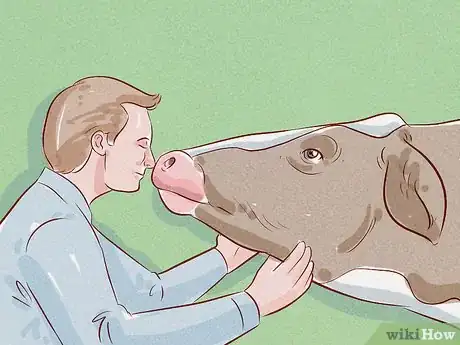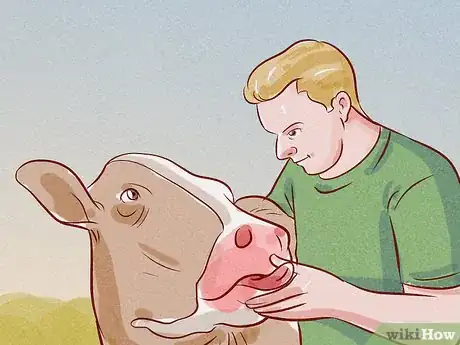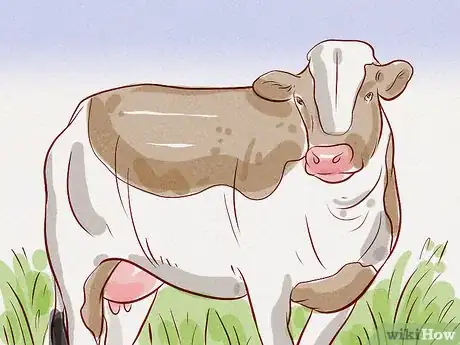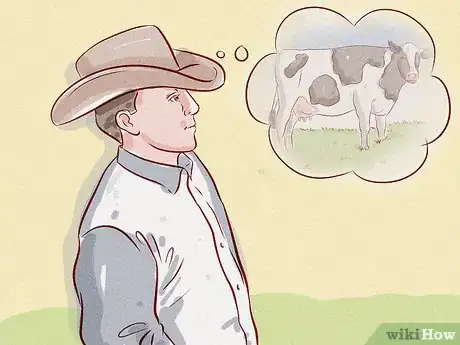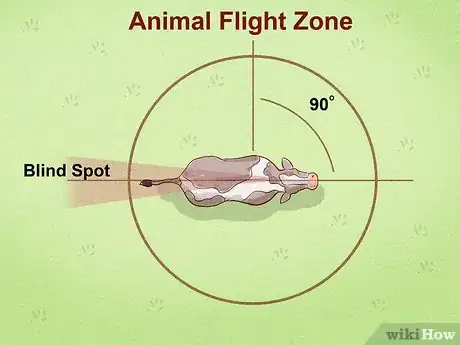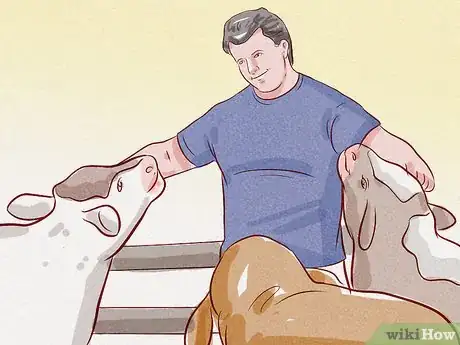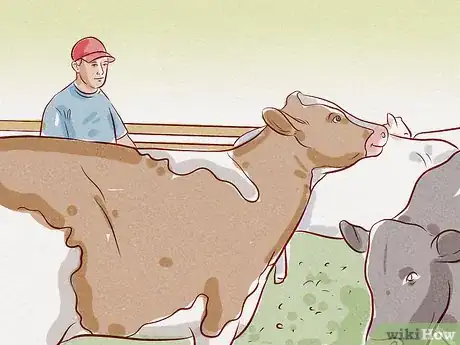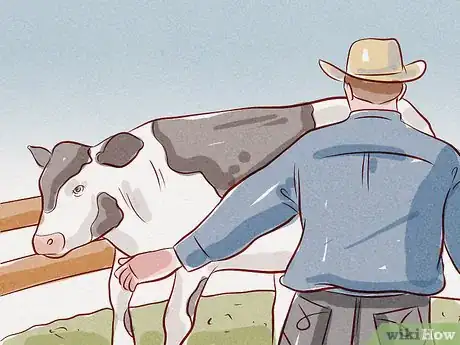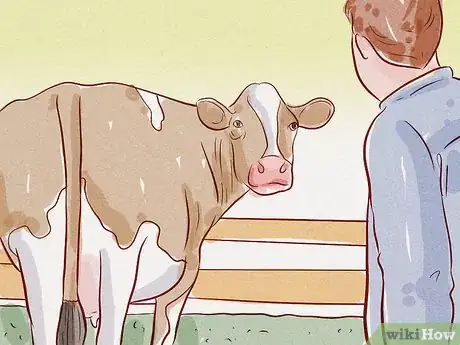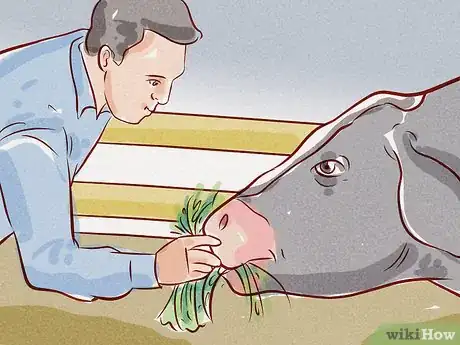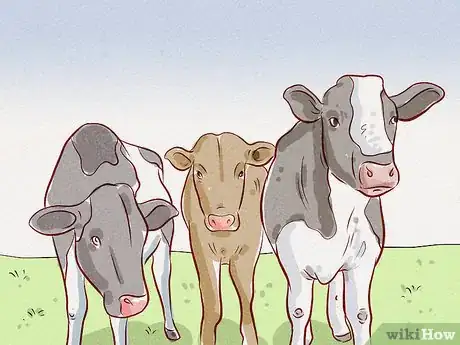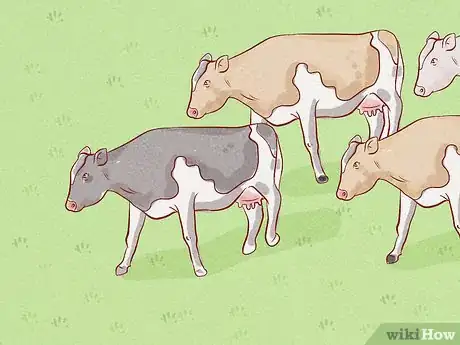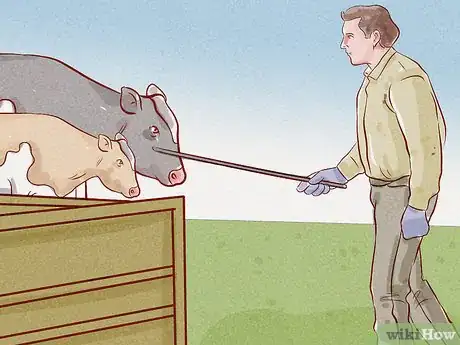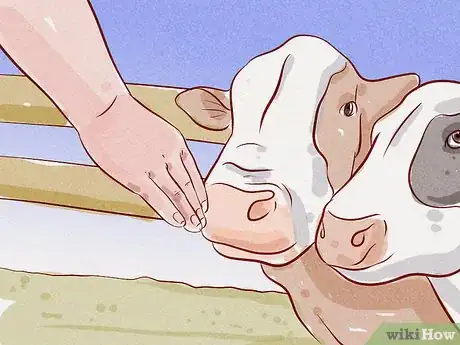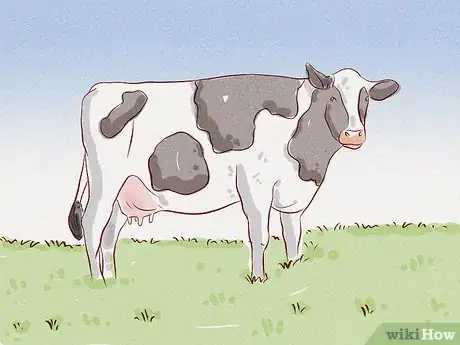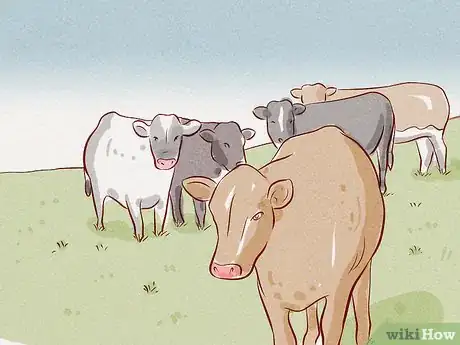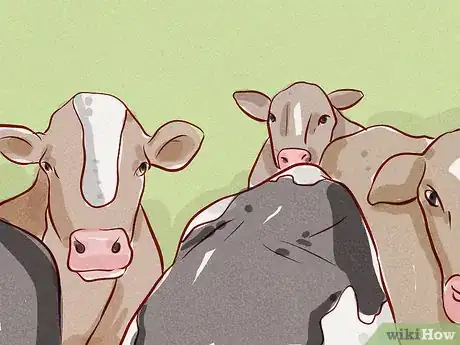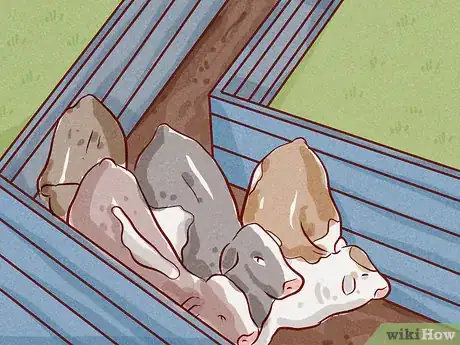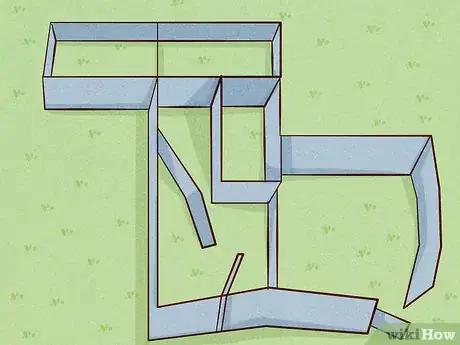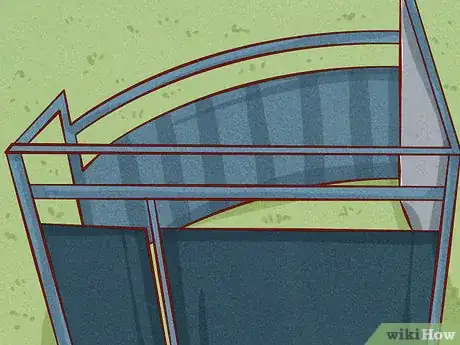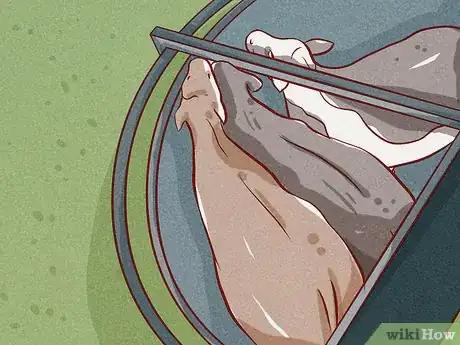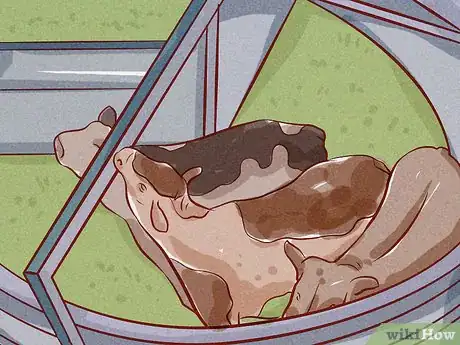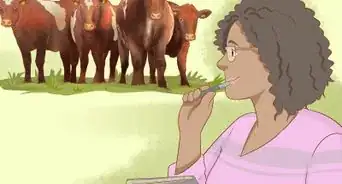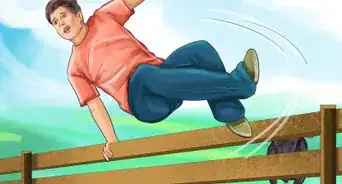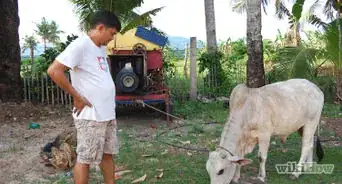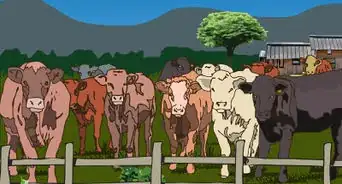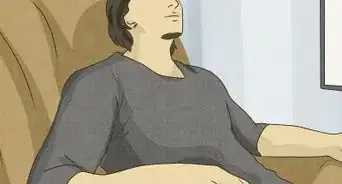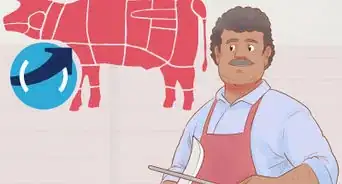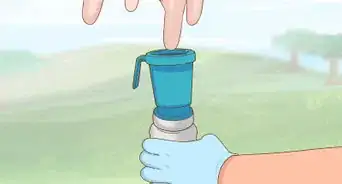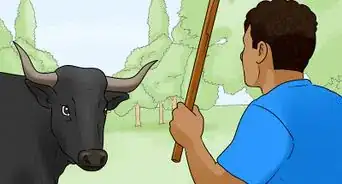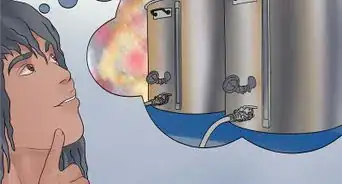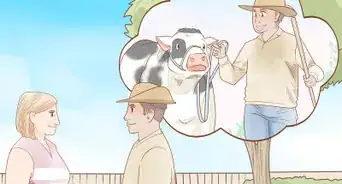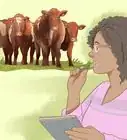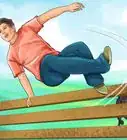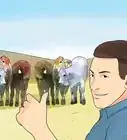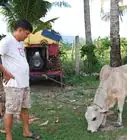This article was co-authored by Karin Lindquist. Karin Lindquist earned a BSc in Agriculture as an Animal Science major from the University of Alberta, Canada. She has over 20 years of experience working with cattle and crops. She's worked for a mixed-practice veterinarian, as a sales representative in a farm supply store, and as a research assistant doing rangeland, soil, and crop research. She currently works as a forage and beef agriculture extension specialist, advising farmers on a variety of issues relating to their cattle and the forages they grow and harvest.
There are 7 references cited in this article, which can be found at the bottom of the page.
This article has been viewed 137,312 times.
Herding cattle is both an art and a science because it requires a surprising amount of knowledge of bovine psychology and behavior. We'll help you learn the basics of herding, but don't be surprised if it takes a good bit of practice before you really get the hang of it.
Steps
Understanding Human-Cattle Interactions
-
1Acknowledge how your frame of mind and behaviour will influence animal movement. All animals, including cattle, are incredibly sensitive to our attitude and our frame of mind, and will always be a mirror to what we're actually feeling, even when we don't realize it at the time. If you are excited or tense, they will also be excited and tense. If you are calm and quiet, they will also be calm and quiet.
- When working with cattle, then, it is so very important to be in the right frame of mind because cattle are more likely to respond well versus if you were not in the right frame of mind.
- In other words, if you are working cattle in an anything-but-calm emotional state, those animals are surely going to be anything but calm too.
- You may find that you can work with cattle--and this goes for any other animal, dogs, cats, goats, horses, or even chickens--if you allow yourself to have a clear head and a calm attitude. You may find that, by putting yourself in a calm state, you will be able to think more clearly and deliberately communicate your intentions to the animals you are working with. And the animals are less likely to be confused as well.
- Your behaviour has a huge influence on how even an individual cow, not to mention an entire herd, regardless of size, will perceive you. If your behaviour is such that you don't care or are holding back too much, they'll take advantage of that and not interested in doing as you ask. On the opposite spectrum, if you're too aggressive and forceful, they also won't be interested in listening to you. So, to be successful, pick the middle of the road: Be intentional in your actions, be deliberate, and be assertive, but never to the point of being aggressive and forceful.
-
2Understand the difference between human instinct versus bovine instinct. Just to give you a taste, humans and cattle sit at the opposite end of the spectrum: We have humans, which are predatory animals, and cattle, which are prey animals.
- Humans, as predatory animals, aren't much different from other predatory animals in how we perceive ourselves and those around us. When working with animals, not just cattle, our instincts are to:
- Slow or stop animals
- Want animals to face us; give us eye-contact, not turn away (because, to us this means they're "going to run away.")
- Keep pushing or push from behind, even when animals are already on their way and know where they're going.
- Circle around (classic predatory behaviour), to "cut off" or, as already mentioned, stop or slow down animals.
- To give chase because we think something is trying to run away. (This goes right back to instinctually wanting to slow or stop an animal.)
- Not to back up, but rather stay put or just keep pushing forward, or even turn away.
- Cows and other prey animals (horses, goats, bison, sheep, chickens, elk, buffalo, and even pigs) think differently from us. Their instincts are to:
- Want to see what is pressuring them.
- Move in the direction they are headed (i.e., if they want to go to that patch of woods, that's where they'll go; if they're heading straight they'll go straight).
- Follow other animals.
- Have very little patience. In other words, they won't wait around for long if you're trying to figure out how to move them, so they'll just keep going or doing what they were going to do in the first place, or whatever first pops in their heads.
Advertisement - Humans, as predatory animals, aren't much different from other predatory animals in how we perceive ourselves and those around us. When working with animals, not just cattle, our instincts are to:
-
3Recognize the possibility that instinctual human behaviour has a significant influence on how animals are going to respond. We have to remember that, because cattle are prey animals, they are going to respond as prey animals will, and that is if they find any animal acting as a predator, regardless if it's a wolf or a man, they will act as any prey animal will and choose flight first before stopping and facing said predator as a last-ditch defence. Cattle instinctually know how to avoid predators; those that have had to live for extended periods without human contact (and there are many of such animals that exist in many parts of the world), have had to tap into those instincts to survive.
- Some livestock handling methods recommend to "act like a predator" to successfully move cattle, but these methods may not always work, because it doesn't build trust nor give your animals the means to believe that you are not there to hurt them or cause fear. Instinctively, predatory actions induce fear into prey animals, which goes hand-in-hand with mistrust. Just like you'd want your horse to trust you enough to allow you on his back, you should want your cattle to trust that you are going to move them to some place where they feel safe, and also move them in a way that they are all going to willingly go there.
- You can easily tell if your animals do not trust you and don't want to do as you are "asking" by the way their heads are held (high up, ears pricked, bodies tense with that "look" like they're ready to flee), and how they are hesitate and resistant to move.
- Some livestock handling methods recommend to "act like a predator" to successfully move cattle, but these methods may not always work, because it doesn't build trust nor give your animals the means to believe that you are not there to hurt them or cause fear. Instinctively, predatory actions induce fear into prey animals, which goes hand-in-hand with mistrust. Just like you'd want your horse to trust you enough to allow you on his back, you should want your cattle to trust that you are going to move them to some place where they feel safe, and also move them in a way that they are all going to willingly go there.
-
4Understand how cattle think and what they like to do. Going back to the second part of step 2 above, the instincts of cattle are basically from that of a one-track mind: They just want to go where they're headed, see what's pressuring them, and follow others. Going beyond that, when working closely with cattle, some extra points to realize that livestock like doing:
- Livestock like to go by us;
- They also like to go around us.
- Cattle always like to go back the same way they came from; they prefer to go back to the last place they felt safe.
-
5Familiarize yourself with how cattle move in response to pressure. Each individual animal has what is called a "flight bubble" or "flight zone", which can also be called a "pressure zone", though arguably the pressure zone is just slightly outside of the true flight zone. This zone is basically an invisible oval bubble surrounding the animal. Its size varies for each animal, from almost no discernible zone, to a zone that can be least 50 yards (46 m) in size. For example, bison typically have a larger pressure/flight zone bubble than cattle do.
- This "bubble" is used as a means to move animals, done so in a way that it takes advantage of an animal's zone of comfort as well as point of vision. Thus, when moving an animal, you should always be where the animal can see you.
- Cattle have a 330º field of vision. They don't see very well right in front of their noses and can't see directly behind them, so do not pressure them at either of these points. Instead, to take advantage of this pressure zone, you must apply pressure from either hip or either shoulder right up to the neck.
- A cow will move forward if you continually correct her, from the hip or by crossing in behind, whenever she needs to turn her head to see you.
- This is why it's so important to make sure you are where you can be seen!!
- To turn an animal, go in the opposite direction of where you want the cow to go, just like you would with backing up a trailer.
- If an animal is turning to look at you, it's because you're not in a place where they can see you or feel you pressuring them to move. Either you need to move out farther to the side, or you need to move closer.
- A cow will move forward if you continually correct her, from the hip or by crossing in behind, whenever she needs to turn her head to see you.
- Cattle have a 330º field of vision. They don't see very well right in front of their noses and can't see directly behind them, so do not pressure them at either of these points. Instead, to take advantage of this pressure zone, you must apply pressure from either hip or either shoulder right up to the neck.
- Manipulating this bubble so that the animal goes to where you ask it takes patience and knowing how to move on your part. You will not always be moving forward, you will have to often either stop, move away, walk with the animals, or back up to release pressure off the animal.
- This "bubble" is used as a means to move animals, done so in a way that it takes advantage of an animal's zone of comfort as well as point of vision. Thus, when moving an animal, you should always be where the animal can see you.
-
6Understand why release is important after applying pressure. Release is a form of reward and a way to remove the stress we put on animals to get them moving in the direction we ask them to. Release works hand-in-hand with pressure, and should always be kept in conjunction with pressure in order to give animals the sense that they're doing something good and that it's always going to come after pressure is applied.
- To apply release is to slow down, stop, move away, walk with the animals, or back up, depending on the location of where animals are being handled and how they are responding to pressure. Doing these will not only relieve pressure on the animals for us to be able to make necessary adjustments, but also draw animals toward us, or slow down/stop the animals.
-
7Watch some cattle handling videos by stockmanship experts to get a feel of what's involved. The first taste of learning proper herdmanship or stockmanship of working cattle is going to seem confusing and will require lots of practice and continual learning. Bud Williams, for instance, was always learning how to best handle cattle up to when he passed away. Other stockmen like Steve Cote, Richard McConnell and Tina Williams, Dylan Biggs, and Curt Pate are other good people worth looking into and learning more from. Temple Grandin is also good for a lot of basics with handling cattle.
Herding with Cattle in Pasture or Corral
-
1Realize that each situation you walk into will be different. You will want to do and try different things with them, and they will certainly be posing different challenges for you that you need to be ready for and let the animals teach you about. No herding scenario is going to be perfect each and every time.
-
2Assess the animals. Watch their behaviour before you go in and gather them up. They may already be laying down or watching you intently with the ears pricked and heads up. You will need to react and start them accordingly.
-
3Get them up and started. The first thing, and most important thing, that you need to do is to get the herd started. This is also the first part of training of both you and the cattle to drive properly. Getting started is generally getting the herd gathered up enough that you're getting good movement from them. The herd, as from step 2 above, may either be calmly laying down and chewing their cud, or watching you intently as you move closer to them. The added difficulty will be when working with cattle that have not yet been trained to herd properly, so be prepared for some flighty animals at first.
- It's important to give them time to think and gather themselves up–let them stretch, if you have cows to gather up and join up with their calves, take a few bites of grass, etc.–before getting them moving. Allow them to take a few steps ahead before you begin pressuring and guiding them to generate that good movement.
-
Good movement means that animals will be moving freely and comfortably, acting and feeling relaxed with their heads bobbing as they walk along.
- When animals are going in the direction you want them to, stragglers will be drawn in to the main herd, and they will even stay where you "place" them if good movement was used to get them there.
- If they are flighty and high-headed, don't feel the need to rush into things. Instead, go slowly and take your time. If they run away, let them. But you will need to keep moving and trail them where they go, never moving at them, directly behind them, nor curve around them. Make straight lines as a form of pressure-and-release until they settle down and realize you are not a threat.
- If animals are laying down and quietly chewing their cud, then you will need to get them up. To do this, walk to the hip or shoulder until they make the movement to get up, then immediately move away to the next animal. If there's an animal already getting up before you get to it, move away from that and keep going until all animals are up and ready to go.
- It's so important to never ever give that one little extra push when they're already doing what you want them to do. Once they're already up and/or moving away, then just let them. You can come back and correct where they're going soon enough.
- The hardest part of getting them started is actually getting them started. The next problem is getting them going in a direction you want to go and leaving them alone as soon as they do so. The other challenging part is how far out, in a straight line, you need to go to get animals moving or to turn them without compromising movement or direction of travel. This will take much experimenting on your part and continual reading of how animals will respond.
-
4Develop good movement of the herd. Once the animals are up and beginning to move, you will need to move in straight lines–never straight to the head nor straight at the rear–to get the herd moving in the direction you want to go. The rule of thumb to use is to generally move perpendicular to the direction the herd should be going; when walking behind a herd in a pasture, this means straight zig-zag patterns.
- When making zig-zags, it's completely fine to cross behind an animal, and to make an angle to the hip, shoulder, belly or neck of the outside animal to get maximum influence of movement. Just remember, once the animal is going in the direction you want it to, leave it immediately.
- Think of moving a herd being like moving a wall by yourself. You have to walk to one edge and back to another to get movement going straight ahead. If you want to turn a certain way, little movement is needed on one end versus the other, depending on how sharp or wide a turn that needs to be made, and how much space you have to do it.
- To move a herd to the right, go left. To move a herd to the left, go right.
- This is no different when trying to turn an individual cow. In order to get her moving straight, zig-zags back and forth to guide her is what will get her going straight, relatively speaking.
- To move a herd to the right, go left. To move a herd to the left, go right.
- Depending on how far strung-out the herd is, the zig-zag pattern may vary from one step in one direction and another step the other, or several steps one way and several steps the other way. Use your animals (and your choice direction) as a guide to tell how many steps you need to make one way versus another.
-
5Maintain good movement. As already mentioned, good movement is achieved when animals are relaxed, their heads are bobbing as they walk, and they're moving at a comfortable pace. Other stock will be drawn out from wherever they are hiding, and come in to the main herd. It's important to not pay much attention to these stragglers, but also to make sure you are not ahead of the rear-most animal.
- You too must maintain that zig-zag pattern to keep that good movement going, as the points and steps above have already mentioned. There is no defined number of steps you need to cut in or out to maintain good movement and direction; this is far more of a matter of constant trial-and-error and learning to read your animals effectively.
- Good movement isn't always nor necessarily slow and steady. If animals are feeling a little frisky and lively, they may run for a little ways, and you'll have to do your part to keep up! And if they want to move slow, then let them move slow.
- You can also control their speed. If you angle a bit more harder into them, they will speed up. Angle less into them, they will slow down.
- A herd with good movement will always draw in the stragglers, no matter where they are.
- Animals will tell you if you are too close or too far behind. Too much turning may mean you need to back off and give them a little more space. But if they're turning around to look at you, you may need to either move up closer, or move farther out.
- It's less important to know where the gate is than it is to get them going in a direction you want them to go. Adjustments to direction may need to be made if there are certain objects in the way–ranging from a hill to a telephone pole–but generally the direction of travel should go back to where you are intending.
-
6Move them towards and through the gate. While this may sound like a scary challenge, it doesn't have to be. Just remember, always "T to the gate." Think of an upside-down T, with the end of this upside-down T at the gate, and the perpendicular line to this T your direction of travel. The herd is along the line between the gate and your perpendicular direction of movement.
- Your job is to guide the herd from the rear towards the gate opening, guiding from the corners and pressuring from the side. This T will be continually shifting according to the changes made by the herd. Remember, you are always working back and forth in a straight, zig-zag pattern.
- If the herd is not moving in a straight line to the gate, then shift your line so you continue to work in a straight line to the gate. Your "angle of attack" should always be move right to move the animals left and move left to get the animals to move right.
- Continue with this T to the gate even as they go through. It's very important to never encircle the herd or create a horse-shoe because this could cause one or more animals to break away from the gate. Keep working in a straight line until all animals are through that gate.
- It's also critically important to never post someone near the gate. This actually distracts the animals and causes some to break away.
- In other words, if you are worrying about animals not going through the gate, and feel the urge to go and "correct" some potential movement, then don't. You are more likely to create the very problem you're worried that's going to happen; rather, you are more likely to make animals not go through the gate if you try to "correct" them versus if you just maintained your T to the gate movements until all animals are past that gate.
- The "T to the gate" is very similar to and can be also used when loading cattle onto a trailer in the middle of a pasture.
- It's also used for any size of herd. But the larger the herd, the larger the T, and the more people that may be needed to form this T to the gate.
- This method, used properly, will eliminate the need for using fences as wings to funnel cattle into a gate or onto a trailer. Wings to a gate only act as a bottle-neck to crowd animals in, and can cause more trouble than they're worth.
-
7Slow them down or stop them. In order to slow them down and stop them, walk parallel to or with the animals. This will naturally get them to stop or slow down.
- Stopping is another part of a training exercise that is important with working cattle. They are easier to handle when they (and you) understand the art and science behind starting and stopping movement.
Separating One or More from the Herd
-
1Perform the steps mentioned above for starting and developing good movement in a herd. It's always important to get the start of movement going before you focus on separating out some select animals from the main group.
-
2Focus on one or more animals to split out. You should have already assessed the group for the ones you want to split from the herd, so keep an eye on them and begin to ignore the rest.
-
3Begin working animals so that you are walking past the ones you don't want to bring with you. When you walk past these animals, they will slow down and stop. The ones still ahead of you should continue movement as long as they can see you are still applying pressure and release with your zig-zag movements.
- Ignore the other animals that want to follow, unless one or more of them are a part of the group you want to gather up. The other "unwanted" cattle will soon figure out you do not want them with the group you're herding; they will soon stop and go about their own business.
- If you are splitting out just one animal, and they are not used to you driving them, they may try to stop and "challenge" you or try to get back to the herd.
- If they are facing you in a challenge, just stop, and shift your weight from one foot to another to allow them to think. If they make a move to go around you, step in that direction to discourage that movement. Repeat until you teach the animal to understand that you mean no harm, and you just want them to walk with you, yet you are still the boss and are the one responsible for leading or herding them to where they should go.
- This may take a few minutes, but take your time, and keep watching and reading the animal.
- If they do break away back to the herd, then repeat the process again until you are able to successfully drive the cow, heifer, steer, or even bull without them trying to get around or challenge you.
- If they are facing you in a challenge, just stop, and shift your weight from one foot to another to allow them to think. If they make a move to go around you, step in that direction to discourage that movement. Repeat until you teach the animal to understand that you mean no harm, and you just want them to walk with you, yet you are still the boss and are the one responsible for leading or herding them to where they should go.
- There is no need to worry if there's one or two extra cattle in with the group that want to stay with the group. You can split them off later on, when they move from the front of the herd to the back. Once they get near the back you can adjust your movements so that you are no longer applying pressure for them to stay with the group you've already collected.
-
4Herd the animals, similar to that mentioned in the last section, to the place where you want to place them. Your zig-zag movements will be minimal for a small group or one animal. But you are always going to be guiding from the corners and pressuring from the sides.
Putting Cattle Through a Handling Facility
-
1Move cattle from the pasture or corral using the steps from the sections above into a holding pen. This pen will be the first place where your cattle are going to move into and through the handling facility.
-
2Move a smaller group from the main holding pen (or one of them if there is more than one such pen) into a smaller pen or holding alley. This is a good time for sorting cattle if this needs to be done. Use the same principles and practices mentioned above for splitting out one or more cattle from the main herd, without actively herding them.
- It's important to never push from the back, but rather move from the front, through the gate from where you want the animals to go.
- When working in a smaller area there is less room for error and less time to react. But the basics still apply with controlling movement. In this instance, you can stand beside the gate, or move in towards the back if this is a long pen, and move a step forward or backward to stop or encourage movement through the gate.
- The wider the gate, though, the more in the opening of that gate you will need to stand.
- Standing by the gate and moving back and forth (or side to side, depending on the shape of the pen and where the animals are in that pen) will slow down the number of animals that enter the holding alley leading to the next pen. You are usually not wanting all animals to go through, but only a certain amount out of a larger herd at a time.
- There is almost no need to have someone going in behind the group to push them up. That is, unless there's a big area behind them where they shouldn't be. If there's enough crowding going on that the pressure you apply when at the gate makes them go through that gate, then you are only needed at that gate and not needing someone else behind to move them up.
- It's important to never push from the back, but rather move from the front, through the gate from where you want the animals to go.
-
3Move the first small group into the crowding tub or bud box. You only need a group of half a dozen head in a 14' by 20' box (or a group of four or five for a 12' crowding tub) to work with.
-
4Put them down the working alley from the tub or box. In a Bud box system, you only need to be standing right by the opening they're to go through. Just as with the second step above, stepping forward or backward will control movement through to the alley. Some instances you just need to stand there to encourage them to go by and around you to feel like they're going to go back the way they came.
-
5Encourage movement into the squeeze by walking in the opposite direction that they are to go. In order to get to that point, when you step away from the box or tub, make a wide loop around then walk straight up the chute towards the tub. They will quickly go to the head-gate or squeeze chute.
- If you have a calf or cow that gets turned around in the alley, then just walk down the alley from the box or tub to get them back into the tub or box. Repeat your stance by the opening to the alley. If the calf balks before the squeeze, then once again, make a wide loop towards the squeeze or head-gate then walk up beside the alley to encourage movement forward.
-
6Process each animal in the squeeze or head-gate, or just hold them for a few seconds then release them. Repeat the same steps as above for the next group of cattle.
Community Q&A
-
QuestionIs it ok to lead a group of cattle?
 Community AnswerAbsolutely. If you can't herd them, lead them! Bribery helps with a bucket of feed to entice them to follow you. If they already associate you or something else to feed, that will be enough to get them to follow you. Calling them (they learn to associate a certain call with feeding time) also helps, especially if they know you and know what your tone of voice means. Cattle are smart animals, smarter than most people give them credit for!
Community AnswerAbsolutely. If you can't herd them, lead them! Bribery helps with a bucket of feed to entice them to follow you. If they already associate you or something else to feed, that will be enough to get them to follow you. Calling them (they learn to associate a certain call with feeding time) also helps, especially if they know you and know what your tone of voice means. Cattle are smart animals, smarter than most people give them credit for! -
QuestionDoes a farmer have the right to block the highway before the cattle have reached their pasture?
 KarinTop AnswererWhen cattle are on the highway, being herded to another pasture, it is wise to make sure the flow of these animals is not interrupted by traffic. Drivers have the responsibility to slow down or stop to make sure this flow is uninterrupted as well. Blocking the highway may not be needed, especially if there are ditches where cattle can be moved through instead, and they just have to cross the highway only once. However, it is best to check with state or provincial road/transportation reps to familiarize yourself with the laws regarding moving cattle.
KarinTop AnswererWhen cattle are on the highway, being herded to another pasture, it is wise to make sure the flow of these animals is not interrupted by traffic. Drivers have the responsibility to slow down or stop to make sure this flow is uninterrupted as well. Blocking the highway may not be needed, especially if there are ditches where cattle can be moved through instead, and they just have to cross the highway only once. However, it is best to check with state or provincial road/transportation reps to familiarize yourself with the laws regarding moving cattle. -
QuestionHow fast does a herd of cattle move?
 Community AnswerThey can be as slow as normal walking pace, or as fast as a horse can run at a full gallop. When a herd of cattle get like that, that's a full-on stampede. Cattle are much harder to work with when they're on a full run than when they're walking or standing still in a group.
Community AnswerThey can be as slow as normal walking pace, or as fast as a horse can run at a full gallop. When a herd of cattle get like that, that's a full-on stampede. Cattle are much harder to work with when they're on a full run than when they're walking or standing still in a group.
Warnings
- Over-pressuring a cornered animal is asking for a lot of trouble. Such an animal will try to hurt you in order to escape. Listen to your animals: If they are acting like they are cornered, back up for as many steps as necessary to release that pressure.⧼thumbs_response⧽
- Do not yell or chase cattle, as this will only increase stress, and may cause some animals to become aggressive when they feel cornered. Cornered animals are very dangerous, and may seriously injure or even kill you.⧼thumbs_response⧽
- Bulls are still dangerous animals to work with. They have much less patience than cows do, so to avoid any excitement or threat of injury, work bulls as a group or with cows.⧼thumbs_response⧽
- Wild, excited movements (like waving arms) can create more problems than you think. Stay calm, keep your arms at your sides or on your hips, and talk low or very little to your animals. Calm and quiet is the quickest and easiest way to work with livestock.⧼thumbs_response⧽
